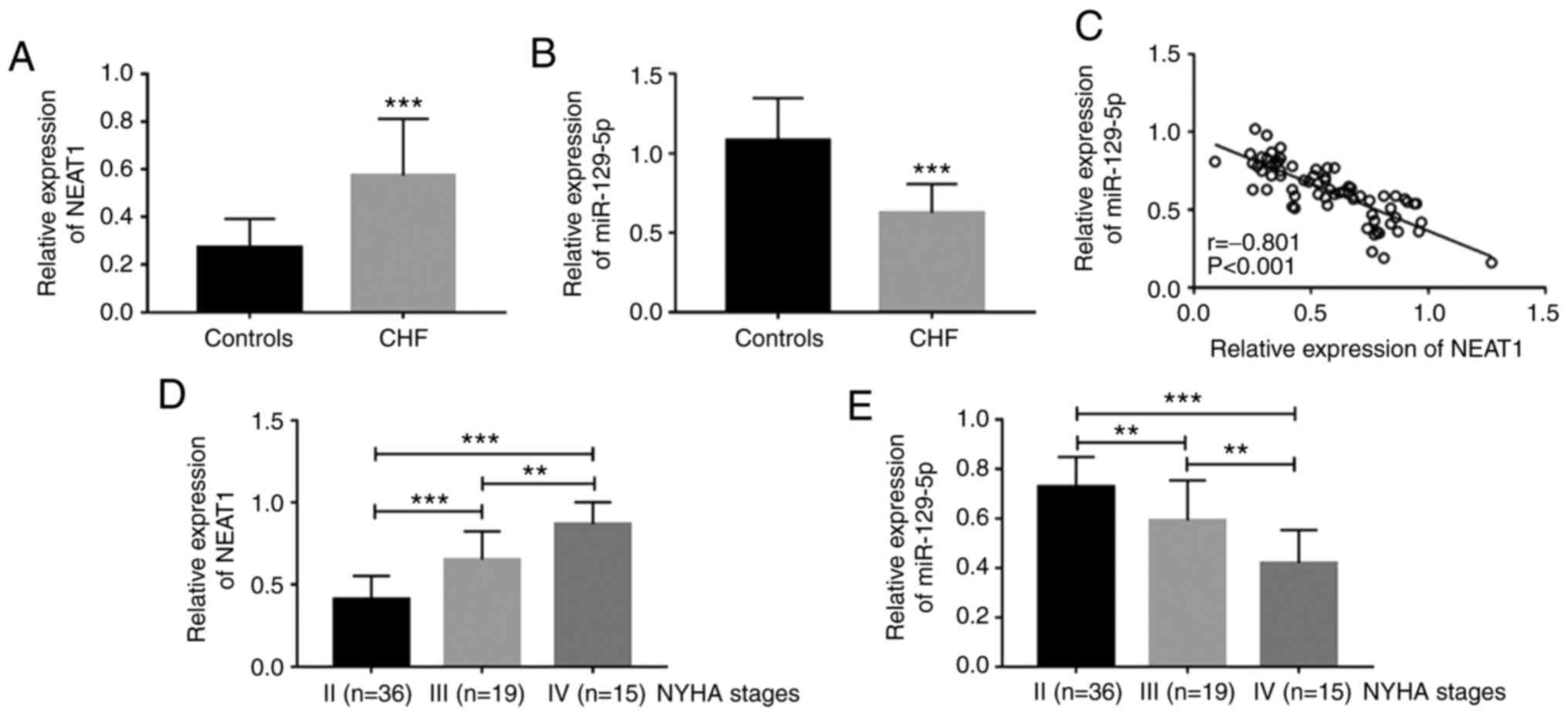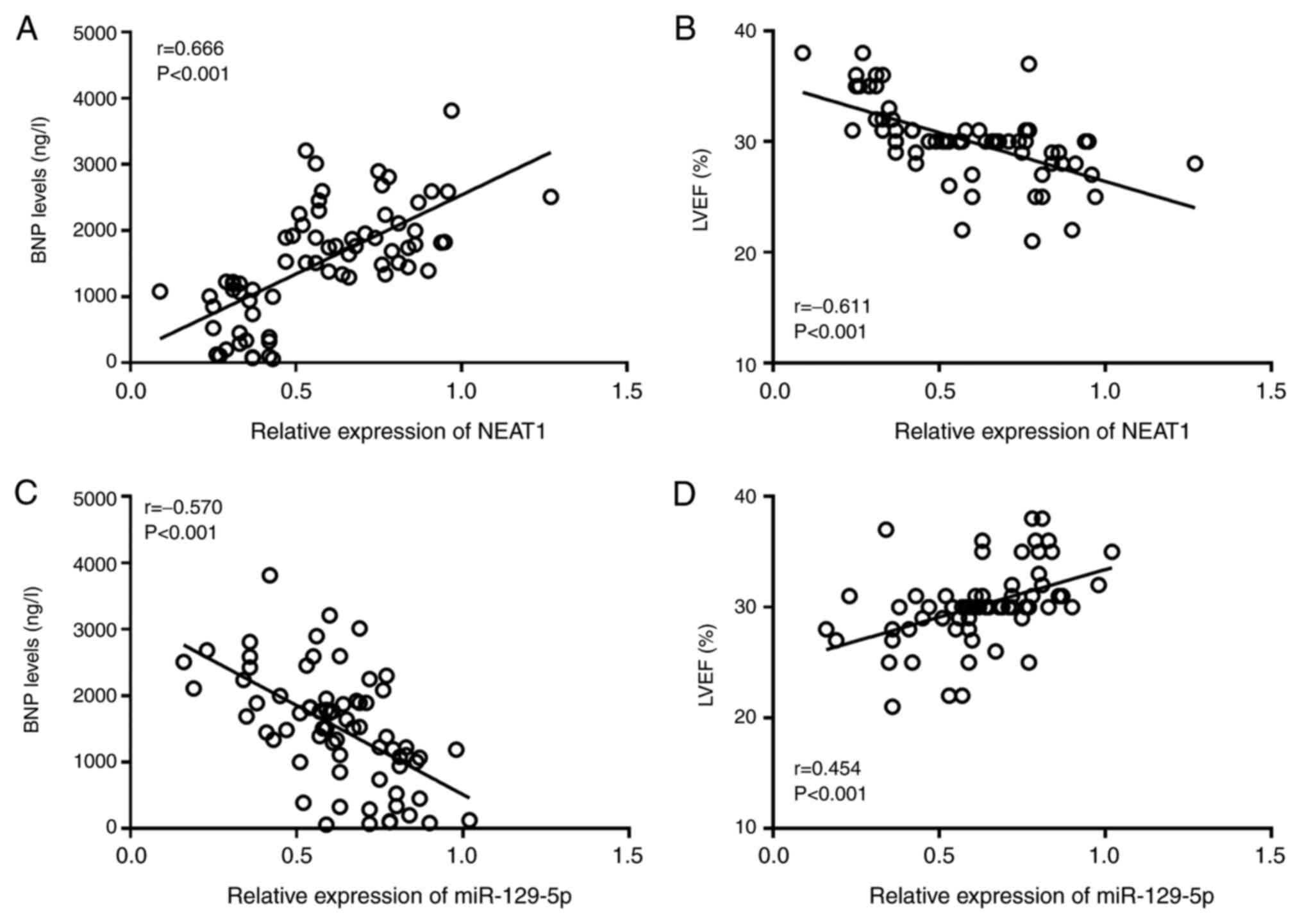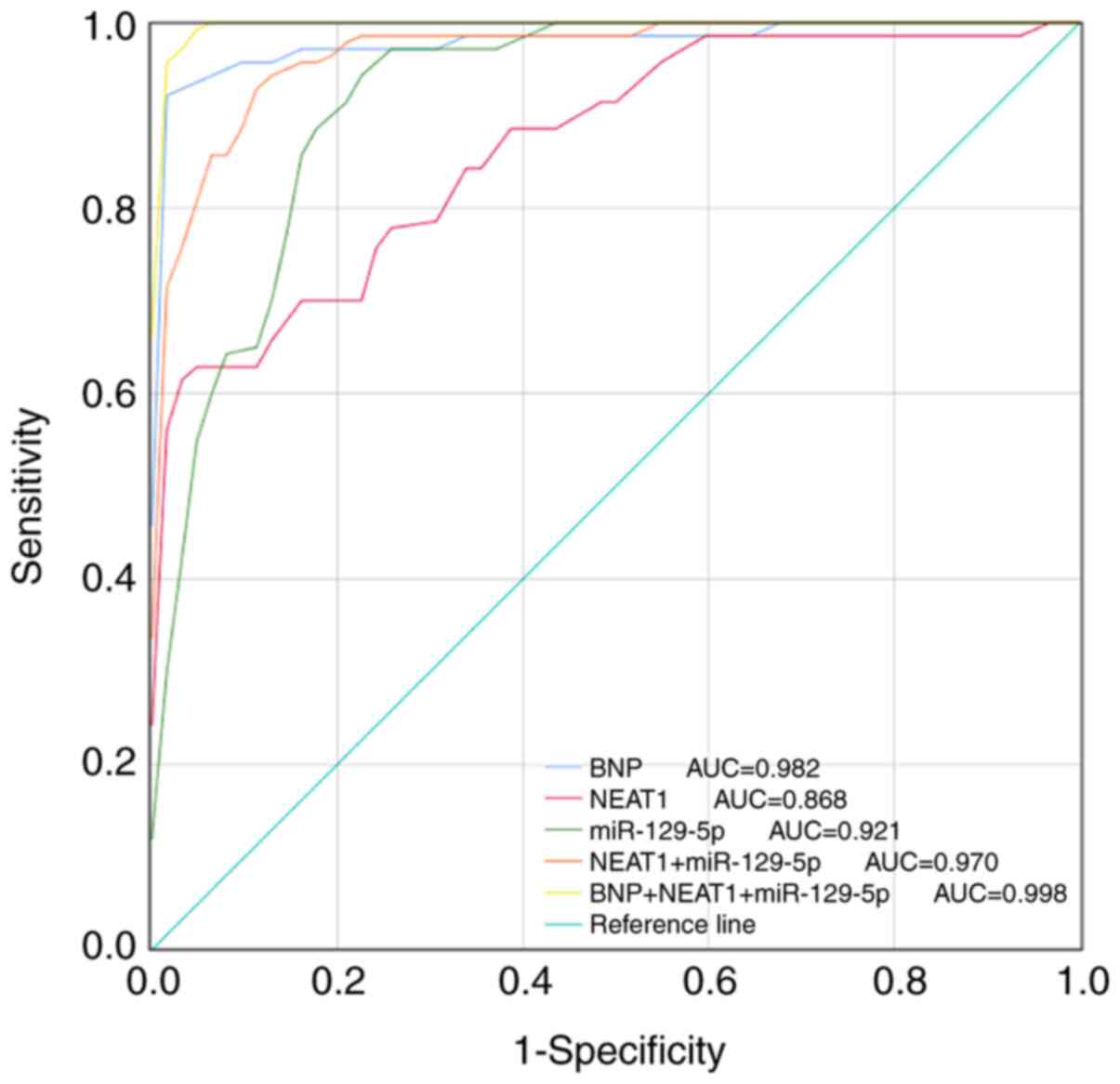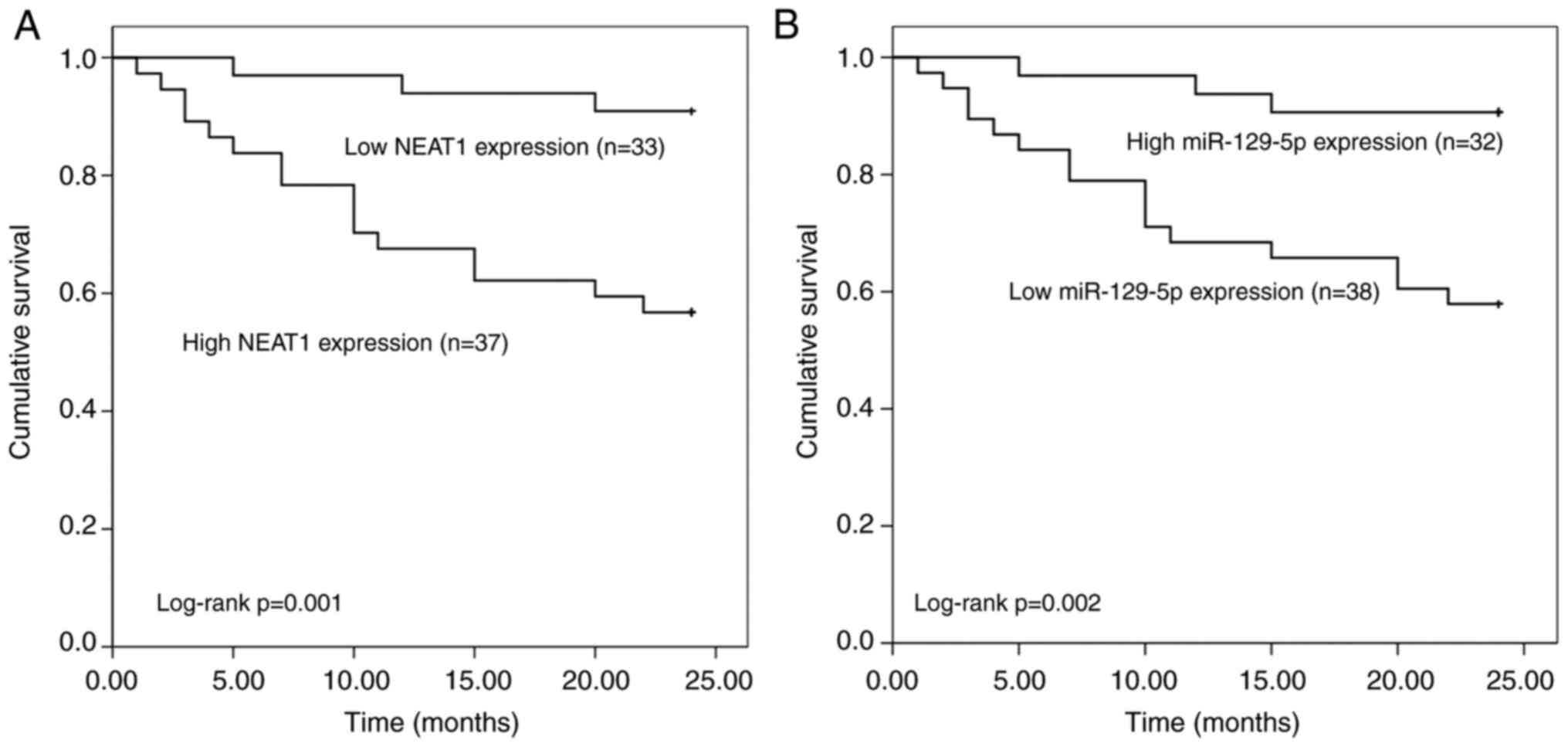|
1
|
Weir HK, Anderson RN, Coleman King SM,
Soman A, Thompson TD, Hong Y, Moller B and Leadbetter S: Heart
disease and cancer deaths-trends and projections in the united
states, 1969-2020. Prev Chronic Dis. 13(E157)2016.PubMed/NCBI View Article : Google Scholar
|
|
2
|
Writing Group Members. Mozaffarian D,
Benjamin EJ, Go AS, Arnett DK, Blaha MJ, Cushman M, Das SR, de
Ferranti S, Després JP, et al: Heart disease and stroke
statistics-2016 update: A report from the american heart
association. Circulation. 133:e38–e360. 2016.PubMed/NCBI View Article : Google Scholar
|
|
3
|
Bertinchant JP: Brain natriuretic peptide
(BNP) and N-terminal-pro BNP in chronic haemodialysed renal
failure. Arch Mal Coeur Vaiss. 97:881–888. 2004.PubMed/NCBI(In French).
|
|
4
|
Skrzypek A, Mostowik M, Szeliga M,
Wilczynska-Golonka M, Debicka-Dabrowska D and Nessler J: Chronic
heart failure in the elderly: Still a current medical problem.
Folia Med Cracov. 58:47–56. 2018.PubMed/NCBI
|
|
5
|
Carella DM: Brain natriuretic peptide:
It's not about the brain or just another smart polypeptide-It's
about the heart. Neonatal Netw. 34:355–359. 2015.PubMed/NCBI View Article : Google Scholar
|
|
6
|
Antonelli A, Ferri C, Ferrari SM, Colaci
M, Sebastiani M, Zignego AL, Ghiri E, Goglia F and Fallahi P: High
levels of circulating N-terminal pro-brain natriuretic peptide in
patients with hepatitis C. J Viral Hepat. 17:851–853.
2010.PubMed/NCBI View Article : Google Scholar
|
|
7
|
Wettersten N, Horiuchi Y, van Veldhuisen
DJ, Mueller C, Filippatos G, Nowak R, Hogan C, Kontos MC, Cannon
CM, Müeller GA, et al: B-type natriuretic peptide trend predicts
clinical significance of worsening renal function in acute heart
failure. Eur J Heart Fail. 21:1553–1560. 2019.PubMed/NCBI View Article : Google Scholar
|
|
8
|
Jurado-Roman A, Agudo-Quilez P,
Rubio-Alonso B, Molina J, Díaz B, García-Tejada J, Martín R and
Tello R: Superiority of wall motion score index over left ventricle
ejection fraction in predicting cardiovascular events after an
acute myocardial infarction. Eur Heart J Acute Cardiovasc Care.
8:78–85. 2019.PubMed/NCBI View Article : Google Scholar
|
|
9
|
Li J, Li Z, Zheng W, Li X, Wang Z, Cui Y
and Jiang X: LncRNA-ATB: An indispensable cancer-related long
noncoding RNA. Cell Prolif. 50(e12381)2017.PubMed/NCBI View Article : Google Scholar
|
|
10
|
Gidlöf O, Bader K, Celik S, Grossi M,
Nakagawa S, Hirose T, Metzler B, Olde B and Erlinge D: Inhibition
of the long non-coding RNA NEAT1 protects cardiomyocytes from
hypoxia in vitro via decreased pri-miRNA processing. Cell Death
Dis. 11(677)2020.PubMed/NCBI View Article : Google Scholar
|
|
11
|
Wei Q, Zhou HY, Shi XD, Cao HY and Qin L:
Long noncoding RNA NEAT1 promotes myocardiocyte apoptosis and
suppresses proliferation through regulation of miR-129-5p. J
Cardiovasc Pharmacol. 74:535–541. 2019.PubMed/NCBI View Article : Google Scholar
|
|
12
|
Xiao N, Zhang J, Chen C, Wan Y, Wang N and
Yang J: miR-129-5p improves cardiac function in rats with chronic
heart failure through targeting HMGB1. Mamm Genome. 30:276–288.
2019.PubMed/NCBI View Article : Google Scholar
|
|
13
|
Zhang H, Zhang X and Zhang J: MiR-129-5p
inhibits autophagy and apoptosis of H9c2 cells induced by hydrogen
peroxide via the PI3K/AKT/mTOR signaling pathway by targeting
ATG14. Biochem Biophys Res Commun. 506:272–277. 2018.PubMed/NCBI View Article : Google Scholar
|
|
14
|
Yancy CW, Jessup M, Bozkurt B, Butler J,
Casey DE Jr, Drazner MH, Fonarow GC, Geraci SA, Horwich T, Januzzi
JL, et al: 2013 ACCF/AHA guideline for the management of heart
failure: A report of the American College of Cardiology
Foundation/American Heart Association Task Force on Practice
Guidelines. J Am Coll Cardiol. 62:e147–e239. 2013.PubMed/NCBI View Article : Google Scholar
|
|
15
|
Ponikowski P, Voors AA, Anker SD, Bueno H,
Cleland JGF, Coats AJS, Falk V, González-Juanatey JR, Harjola VP,
Jankowska EA, et al: 2016 ESC Guidelines for the diagnosis and
treatment of acute and chronic heart failure. Rev Esp Cardiol (Engl
Ed). 69(1167)2016.PubMed/NCBI View
Article : Google Scholar
|
|
16
|
Caraballo C, Desai NR, Mulder H, Alhanti
B, Wilson FP, Fiuzat M, Felker GM, Piña IL, O'Connor CM, Lindenfeld
J, et al: Clinical implications of the New York Heart association
classification. J Am Heart Assoc. 8(e014240)2019.PubMed/NCBI View Article : Google Scholar
|
|
17
|
Livak KJ and Schmittgen TD: Analysis of
relative gene expression data using real-time quantitative PCR and
the 2(-Delta Delta C(T)) method. Methods. 25:402–408.
2001.PubMed/NCBI View Article : Google Scholar
|
|
18
|
Wan Y and Yang ZQ: LncRNA NEAT1 affects
inflammatory response by targeting miR-129-5p and regulating Notch
signaling pathway in epilepsy. Cell Cycle. 19:419–431.
2020.PubMed/NCBI View Article : Google Scholar
|
|
19
|
Ye J, Lin Y, Yu Y and Sun D: LncRNA
NEAT1/microRNA-1 29-5p/SOCS2 axis regulates liver fibrosis in
alcoholic steatohepatitis. J Transl Med. 18(445)2020.PubMed/NCBI View Article : Google Scholar
|
|
20
|
McCarthy CP, McCarthy KJ and McEvoy JW:
Declining risk of sudden death in heart failure. N Engl J Med.
377(1793)2017.PubMed/NCBI View Article : Google Scholar
|
|
21
|
Ponikowski P, Anker SD, AlHabib KF, Cowie
MR, Force TL, Hu S, Jaarsma T, Krum H, Rastogi V, Rohde LE, et al:
Heart failure: Preventing disease and death worldwide. ESC Heart
Fail. 1:4–25. 2014.PubMed/NCBI View Article : Google Scholar
|
|
22
|
Farnsworth CW, Bailey AL, Jaffe AS and
Scott MG: Diagnostic concordance between NT-proBNP and BNP for
suspected heart failure. Clin Biochem. 59:50–55. 2018.PubMed/NCBI View Article : Google Scholar
|
|
23
|
Collin-Chavagnac D, Manchon M, Traulle C
and Bernon H: False-positive BNP results in a 78-year-old man
caused by monoclonal IgM-kappa: A case report. Clin Chim Acta.
384(179)2007.PubMed/NCBI View Article : Google Scholar
|
|
24
|
Ferre F, Colantoni A and Helmer-Citterich
M: Revealing protein-lncRNA interaction. Brief Bioinform.
17:106–116. 2016.PubMed/NCBI View Article : Google Scholar
|
|
25
|
Song P, Jiang B, Liu Z, Ding J, Liu S and
Guan W: A three-lncRNA expression signature associated with the
prognosis of gastric cancer patients. Cancer Med. 6:1154–1164.
2017.PubMed/NCBI View Article : Google Scholar
|
|
26
|
Chao Y and Zhou D: lncRNA-D16366 Is a
potential biomarker for diagnosis and prognosis of hepatocellular
carcinoma. Med Sci Monit. 25:6581–6586. 2019.PubMed/NCBI View Article : Google Scholar
|
|
27
|
Naizhaer G, Kuerban A, Meilipa Kuerban R
and Zhou P: Up-regulation of lncRNA FALEC indicates prognosis and
diagnosis values in cervical cancer. Pathol Res Pract.
215(152495)2019.PubMed/NCBI View Article : Google Scholar
|
|
28
|
Li Z, Wei D, Yang C, Sun H, Lu T and Kuang
D: Overexpression of long noncoding RNA, NEAT1 promotes cell
proliferation, invasion and migration in endometrial endometrioid
adenocarcinoma. Biomed Pharmacother. 84:244–251. 2016.PubMed/NCBI View Article : Google Scholar
|
|
29
|
Yu X, Li Z, Zheng H, Chan MT and Wu WK:
NEAT1: A novel cancer-related long non-coding RNA. Cell Prolif.
50(e12329)2017.PubMed/NCBI View Article : Google Scholar
|
|
30
|
Wu Y, Yang L, Zhao J, Li C, Nie J, Liu F,
Zhuo C, Zheng Y, Li B, Wang Z and Xu Y: Nuclear-enriched abundant
transcript 1 as a diagnostic and prognostic biomarker in colorectal
cancer. Mol Cancer. 14(191)2015.PubMed/NCBI View Article : Google Scholar
|
|
31
|
Pils D, Tong D, Hager G, Obermayr E, Aust
S, Heinze G, Kohl M, Schuster E, Wolf A, Sehouli J, et al: A
combined blood based gene expression and plasma protein abundance
signature for diagnosis of epithelial ovarian cancer-a study of the
OVCAD consortium. BMC Cancer. 13(178)2013.PubMed/NCBI View Article : Google Scholar
|
|
32
|
Huang Q, Huang C, Luo Y, He F and Zhang R:
Circulating lncRNA NEAT1 correlates with increased risk, elevated
severity and unfavorable prognosis in sepsis patients. Am J Emerg
Med. 36:1659–1663. 2018.PubMed/NCBI View Article : Google Scholar
|
|
33
|
Zhang H, Cai Y, Zheng L, Zhang Z, Lin X
and Jiang N: Long noncoding RNA NEAT1 regulate papillary thyroid
cancer progression by modulating miR-129-5p/KLK7 expression. J Cell
Physiol. 233:6638–6648. 2018.PubMed/NCBI View Article : Google Scholar
|
|
34
|
Lo PK, Zhang Y, Wolfson B, Gernapudi R,
Yao Y, Duru N and Zhou Q: Dysregulation of the BRCA1/long
non-coding RNA NEAT1 signaling axis contributes to breast
tumorigenesis. Oncotarget. 7:65067–65089. 2016.PubMed/NCBI View Article : Google Scholar
|
|
35
|
Fu MC, Yuan LQ, Zhang T, Yan XM, Zhou Y,
Xia HL, Wu Y, Xu LX, Cao X and Wang J: Nuclear paraspeckle assembly
transcript 1 promotes the metastasis and epithelial-mesenchymal
transition of hepatoblastoma cells by inhibiting miR-129-5p. Oncol
Lett. 14:5773–5778. 2017.PubMed/NCBI View Article : Google Scholar
|
|
36
|
Zhang F, Wu L, Qian J, Qu B, Xia S, La T,
Wu Y, Ma J, Zeng J, Guo Q, et al: Identification of the long
noncoding RNA NEAT1 as a novel inflammatory regulator acting
through MAPK pathway in human lupus. J Autoimmun. 75:96–104.
2016.PubMed/NCBI View Article : Google Scholar
|


















